Posts Tagged ‘Triabunna’
Saturday, September 24th, 2011
‘Leave No Trace’.. is an internationally-accepted way of minimising impacts on the places we visit, no matter how we choose to experience them. Applying the principles of Leave No Trace can help ensure the protection of Tasmania’s irreplaceable wilderness and heritage for the future.’
~ Leave No Trace Australia [^http://www.lnt.org.au/programs/7-principles.html]
.
.
‘And it’s whispered that soon if we all call the tune
Then the piper will lead us to reason.
And a new day will dawn for those who stand long
And the forests will echo with laughter’.
.
– Led Zeppelin, Led Zeppelin IV
.
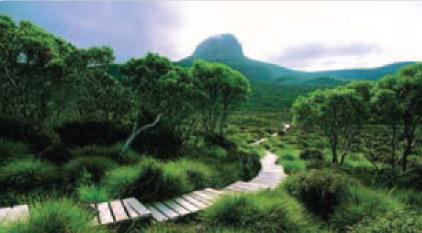 ‘As you visit this special country, please take care to Leave No Trace!’ ‘As you visit this special country, please take care to Leave No Trace!’
(Click this image, then allow the music to play, while you scroll through this article)
.

.
‘Outdoor Ethics’?… do unto Nature as you would have Nature do unto you.
.
Recognise that loud supercilious tourists attract local repulsion, like raw sewage being pumped into a community’s drinking water.
.
.
.
Then there is the Logging World…
.
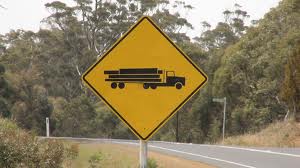 “I am the way and the truth and the life.
No one comes to log except through me.” “I am the way and the truth and the life.
No one comes to log except through me.”
.
A “logger” logs
I am that “logger”
Therefore I log
Therefore I am.
 . .
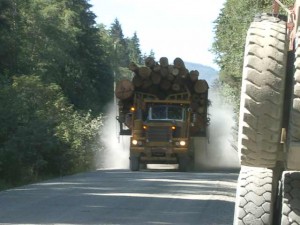 Logging Canada Logging Canada
.
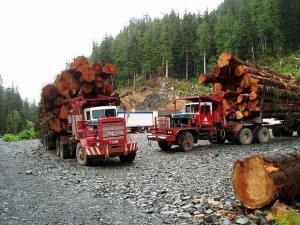 Logging British Columbia Logging British Columbia
.
 Logging Oregon ~ that’s a ‘single rider’ Logging Oregon ~ that’s a ‘single rider’
.
 Logging Tasmania like there’s no tomorrow..and they were right Logging Tasmania like there’s no tomorrow..and they were right
.
 Logging Borneo
~ a rearward perspective Logging Borneo
~ a rearward perspective
(click to enlarge)
.
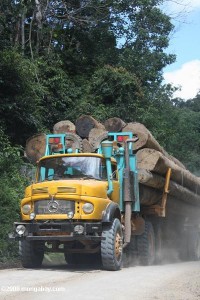 Logging more of Borneo Logging more of Borneo
.
 Logging Gabon, west African rainforest Logging Gabon, west African rainforest
.
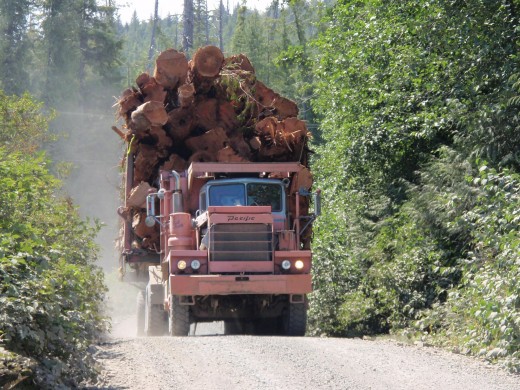 Get out of my bloody way!
It’s logging season and they could change the laws next week! Get out of my bloody way!
It’s logging season and they could change the laws next week!
.
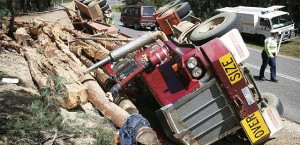 Quality Control in Tasmanian Logging Quality Control in Tasmanian Logging
.
 Triabunna’s Forest Death Camp Triabunna’s Forest Death Camp
.
 Burnie’s Forest Death Camp Burnie’s Forest Death Camp
.
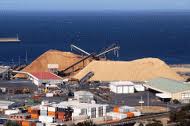 Woodchip Town
~ home of loggers…twenty eight generations at least! Woodchip Town
~ home of loggers…twenty eight generations at least!
.
.
‘Ta Ann’: Forestry Tasmania’s Malaysian Veneer
.
Desperate to find new buyers to justify logging Tasmanian native forests, Forestry Tasmania has sought its Malaysian Solution. The propaganda was that ‘the mills will process regrowth logs only’ and will create local jobs. But after investing tens of millions in two veneer mills, Malaysian logger, ‘Ta Ann’ is now pressuring the government to give them access to Tasmanian native forests to feed the mill monsters. So it was all a veneer of truth.
It all screams of the 1916 ‘Zinc Bargain‘ when the Tasmanian government approved a hydro bulk power contract for the Amalgamated Zinc smelter. By the 1930s, the smelter was swallowing up 3/4 of the Hydro Electric Departments electricity output. Dodgy government deals for big foreign corporates to exploit Tasmania’s native forests. Indeed, Newood mill in Huon built by John Holland the Huon Wood Centre Infrastructure
John Holland has reached practical completion of the stage 2 infrastructure works on the Huon wood centre site required the installation by Transend of a 110kV transmission spur to divert hydro-electrical power from Castle Forbes Bay to power Ta Ann’s Huon mill. .
‘In 2005, Forestry Tasmania was successful in securing the commitment of the Malaysian-based timber company, the Ta Ann Group, to develop two rotary veneer peeling mills in Tasmania at a cost of $65 million. The mills will process regrowth logs only [ed: famous last words] and are to be located ‘in the forest.’
“A rotary veneer mill is an efficient means of adding value to short logs that are not useable for higher-value purposes such as sawmilling,” ~ Bob Gordon (Managing Director of Forestry Tasmania)
In 2007, the first of the mills opened in the Huon district and the second, at Smithton in the North West is currently under construction. When fully operational, the two mills are expected to employ 120 Tasmanians. [ye ol’ jobs lure]
Now many regrowth logs that were previously classified as pulpwood are suitable for the manufacture of rotary veneer for construction grade products. Through Forestry Tasmania’s partnership with Ta Ann, up to 25% of wood that was previously chipped is now ‘peeled’ here in Tasmania for higher value veneer production.’ [Source: ^http://www.forestrytas.com.au/regional-dev]
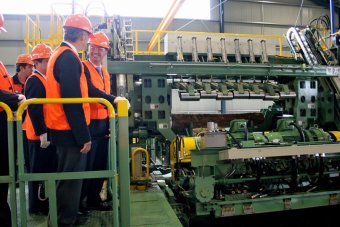 Politicians froth at the prospect of launching anything in front of the media
..here Tasmanian then Premier David Bartlett launching ‘the veneer’ of the Veneer Mill in Smithton in 2008 – ‘plantations only’
. Politicians froth at the prospect of launching anything in front of the media
..here Tasmanian then Premier David Bartlett launching ‘the veneer’ of the Veneer Mill in Smithton in 2008 – ‘plantations only’
.
.
‘The company expects the mill will employ 50 people once it reaches full production. Construction on the $35 million rotary peel mill began in April and last month the company exported its first shipment of veneer to Malaysia.
Today’s symbolic opening was attended by the mill’s Malaysian backers, including the Ta Ann Chairman Datuk Hamed Sapawi, who says Tasmanian eucalypt veneer is particularly well regarded on international markets.
Ta Ann’s first Tasmanian mill in the state’s south began production last year, with the Smithton mill bringing the company’s total investment in Tasmania to $70 million.
Mr Bartlett says the two mills add significant value to timber that would have otherwise been exported as wood chips.’
[Source: ‘Veneer mill officially online’, ABC, 20081128, ^http://www.abc.net.au/news/2008-11-28/veneer-mill-officially-online/222334]
.
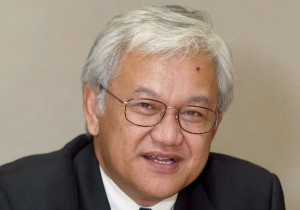 Logging Mogul, Abdul Hamed Sepawi
Malaysian millionnaire boss man and logger pay master – owner of multinational logger ‘Ta Ann’ Logging Mogul, Abdul Hamed Sepawi
Malaysian millionnaire boss man and logger pay master – owner of multinational logger ‘Ta Ann’
.
Sepawi started Ta Ann as a trading firm and now it’s a timber conglomerate with more than 3,000 employees. Ta Ann invests in property development through listed Naim Holdings, which he chairs. Petrol giant Petronas awarded a Ta Ann subsidiary and partner a $780 million deal late last year to build an oil and gas terminal in Kimanis on Borneo.’
But ‘Australian activists are wondering how the Ta Ann Group managed to develop powerful political links in Tasmania. The multi-million-dollar Sarawakian business concern, Ta Ann Group, has managed to secure a grant from the Australian government to invest in a wood veneering factory in Tasmania. Astonished observers and environmentalists, however, are wondering why the Australian government would pay the Sarawak Chief Minister Taib Mahmud-linked company to strip their forest?
Ta Ann is run by Taib’s cousin and well-known proxy, Hamid Sepawi. Sepawi owns a third of the company. According to the Green Party, thus far no satisfactory answer has been provided.
When the project was awarded to Ta Ann, it was with the hope that it would breathe life into a struggling industry.
Ta Ann, when it opened the project, promised that the project would would rely on plantation forests and not extract wood from Tasmania’s remaining high conservation value forests.
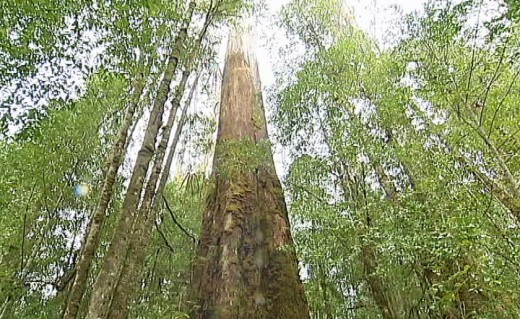 Stihl logged – Tasmanian Native Forests
“Tasmanian eucalypt veneer is particularly well regarded on international markets” ~ Sapawi. Stihl logged – Tasmanian Native Forests
“Tasmanian eucalypt veneer is particularly well regarded on international markets” ~ Sapawi.
.
Tasmania’s primary jungle has been classified as “high conservation value forests”. But recent developments have revealed otherwise. Ta Ann is now pressuring the government to give them access to primary jungle because the quality of plantation wood is not sufficient for their factory and they are demanding hardwood from the jungle.
Environmental group Huon Valley Environment Centre’ spokesman Jenny Weber said the Tasmanian government and Ta Ann were locked in logging the native Tasmanian forests.
“The Tasmanian government and Ta Ann are locking in the logging of native forests to meet a wood supply contract till 2027.
“High conservation value forests are being lost to feed Ta Ann’s mill, when they should be in a moratorium now,” she said.
.
Protests met with contempt
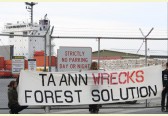 . .
Weber and several activists yesterday boarded a Ta Ann boat laden with wood taken from Tasmania’s primary jungle. They climbed to the top of the boat’s crane tower and chained themselves to it in a bid to draw attention to Ta Ann’s greedy plunder of their own forest.
The protesters are not alone in their anti-logging stance. There has been similar protests and actions like this one in the past, especially in the port areas. These protests have been met with strong-armed tactics and contempt by the authorities.
Earlier this year, the Tasmanian Port Authority announced a 50-metre exclusion zone around all vessels exporting wood chip and veneer. The move is seen as an attempt to prevent protests from holding up Ta Ann’s exports.
There is an overwhelming view among Australians that all logging of primary jungles should be stopped.
Much curiosity has risen as to how this Taib-linked company managed to develop such powerful political links in Tasmania, which is considered to be Australia’s remotest region.
The latest campaign in Tasmania against Ta Ann is a sign of the developing international awareness of Taib and how his greedy pacts with timber tycoons has stripped the Sarawak forest bare.
He and his cronies have spread their tentacles abroad, engaging in plunder across the world’s few remaining areas of virgin jungle.
Tasmania is developing a strong movement to prevent that from happening in its region.
Tasmanian environmentalists now join a legion of other activists across the globe who are against the logging of the world’s remaining forests and the injustices meted out to the indigenous communities in Sarawak and elsewhere.
.
[Source: ‘Why’s Australia ‘paying’ Taib-linked group?‘, 20110719, by Clare Rewcastle Brown, founder/editor of Sarawak Report,^http://hornbillunleashed.wordpress.com/2011/07/19/20969/]
.
.
.
Forestry Tasmania’s Chinese Solution
 Tasmania’s Weedy Sea Dragon
… appropriated for Chinese gain over Tasmania and Tasmanians ~ wake up! Tasmania’s Weedy Sea Dragon
… appropriated for Chinese gain over Tasmania and Tasmanians ~ wake up!
.
‘Forestry Tasmania is always seeking new markets for the Tasmanian forest industry.For example, it has established a new brand in China to promote ‘sustainably harvested‘ Tasmanian peeler logs. Eu Jia Li, (translation: strong and beautiful) is already well respected and it is hoped that it will become a vehicle for a robust trading relationship between Tasmania and China. The Tasmanian weedy sea dragon has been chosen as the brand logo because, like eucalypts, it is indigenous to Tasmania and in Chinese culture, the dragon represents strength and power…for China!
How appropriate a logo! Like Tasmania’s high conservation value native forests, Tasmania’s seadragons have become scarce and are under continual threat from poaching and pollution. The only reason the sea dragon is respected in Chinese culture is because it is killed for backward and superstitious Traditional Chinese Medicine. Traditional Chinese Medicine prescribes seahorses are prescribed from ailments such as asthma, arteosclerosis, dizziness, joint pain, impotence and incontinence. Dried sea horses are consumed for virility.
What is wrong with Viagra? Seadragons in Australia are officially protected by the Federal Government of Australia, but try telling Forestry Tasmania that!
 Here’s a logo to send back to the Chinese loggers! Here’s a logo to send back to the Chinese loggers!
.
.
Forestry Tasmania’s ‘Biomass’ Solution
.
Here’s the greenwash spin for biomass by Forestry Tasmania:
‘As governments around the world grapple with global warming, attention is turning to an age old solution – biomass.
Biomass – essentially organic material such as wood from forests or waste material like cattle dung – is one of the oldest sources of energy and is now undergoing a revival as countries look for alternatives to fossil fuels.
The world’s leading countries in renewable energy production, Denmark, Sweden, Finland, the United States and others in Europe are using forest waste in particular to generate electricity.
Forestry Tasmania has been planning for a biomass plant in the south of the state for at least five years. When it developed the investment ready site at Southwood in the Huon Valley, Forestry Tasmania set aside an area for a biomass plant, to generate renewable energy from forestry debris that would otherwise be burnt.
Using our international contacts, we are seeking investors for this exciting project. If successful, we will not only produce more electricity for the state, but reduce greenhouse gases and the amount of smoke generated by forest fires.’
.
[Source: Press Release: ‘Biomass – a new form of renewable energy’, Forestry Tasmania, ^http://www.forestrytas.com.au/regional-dev, retrieved 20110924]
.
But the historical veneer is that once the furnaces are built, like the veneer mills, the multinationals will pressure the Tasmanian government for more fuel and native forests will become fodder for yet another Forestry scheme. Forestry Tasmania knows this and will argue its age old justification of jobs, job, jobs.
 Like all great loggers, I have seen more than I remember, and remember more than I have seen. Like all great loggers, I have seen more than I remember, and remember more than I have seen.
.
.
Further Reading:
.
[1] Seahorses and Chinese Backward Medicine
.
‘In China, seahorses are prescribed from ailments such as asthma, arteosclerosis, dizziness, joint pain, impotence and incontinence. The fact that dried sea horses are consumed for virility is ironic because sea horse are a species in which the males get pregnant.
Seahorse soup “North is ginseng and south is seahorse” is a Chinese adage from the Divine Peasant’s Herbal Compendium. But Chinese have not been the only ones who consumed seahorses as a medicine. The Roman historian Pliny the Elder reported that “ashes of seahorse…mixed with soda and pig’s large” cured baldness.
In Hong Kong, “inferior” seahorses sell for about $100 a pound, Higher quality ones go for around $400 a pound. The seahorses are usually ground and mixed with herbs and other ingredients a made into a tea. An estimated 2 million seahorse were consumed n China in 1992, a tenfold increase from the previous year. Three million wee consumed in Taiwan the same year.
“North in ginseng and south is seahorse” is a Chinese adage from the Divine Pearls Herbal Compendium . In China medicine seahorses are usually ground and mixed with herbs and other ingredients a made into a tea. They are prescribed from ailments such as asthma, atherosclerosis, dizziness, joint pain, impotence and incontinence. The Chinese are not the only people who have used seahorses for medicine. The A.D. first century Roman historian Pliny the Elder reported that “ashes of seahorse…mixed with soda and pig’s large” cured baldness.
Seahorse sales took off in China when the country began opening up in the 1990s. An estimated 2 million seahorse were consumed in China in 1992, a tenfold increase from the previous decade. Three million were consumed in Taiwan the same year. In Hong Kong at that time “inferior” seahorses sold for about $100 a pound. Higher quality ones went for around $400 a pound.
About 25 million of seahorses were harvested every year in the 1990s. About 95 percent of them were sold in Asia for medicines and aphrodisiacs. They are also collected alive for salt water aquarium and sold dried at souvenir shops. In the 1990s their price went up to $800 a pound.
Wild seahorses are caught by hand, with dip nets or as bycatch from shrimp trawlers. Seahorse hunter generally go after their prey at low tide at night, A good hunter can catch 60 a night. Most are dried and sold to middlemen for the Chinese medicine for about 60 cents a piece.
Seahorses are difficult to raise in captivity. They are picky eaters susceptible to disease and die easily. Thus they are difficult to raise commercially and have to be harvested in the wild. Their monogamy doesn’t serve them well. If one loses a partner he or she doesn’t chose another. The company Seahorse Ireland raises seahorses from birth and has had success getting them to mates and breed in captivity. The company sells seahorses for for $2.50 a piece over the Internet.
Seahorses have disappeared from sea grass beds and mangroves from Florida to Ecuador, and on coral reefs from India to Vietnam. Reefs in the Philippines that were once teeming with seahorses are now almost void of them. So many seahorses have been caught that many species are regarded threatened or endangered. Seahorse habitats—coral reefs, grass beds and mangroves—are increasingly under stress from dredges, overfishing, coral dynamiting and pollution.
In 2003 seahorses were declared an endangered species by The United Nations Convention on International Trade on Endangered Species (CITES). An international ban on seahorse trade was imposed unless the captive-bred or used for scientific purposes. In no-fishing zones seahorses have rebounded.’
[Source: ^http://factsanddetails.com/china.php?itemid=331&catid=12]
.
.
[2] ‘Weedy Sea Dragon Protection – 12 April 2011’
.
‘I want to talk this evening about an interesting marine species known as the weedy sea dragon. It is a charismatic mesofauna that members might be interested to know about! Importantly, it is endemic only to southern Australian waters. It is protected everywhere else in Australia from being taken. When I was involved in marine and coastal conservation, particularly with the establishment of the Cottesloe marine protected area, it came to my attention because weedy sea dragons have been seen in that area. One of the reasons for creating that fish habitat–protected area was to encourage that species, amongst others, to thrive in the area and to protect them from recreational activities. They are greatly admired by scuba and snorkel divers because they are very interesting animals to watch. The fact that they are protected elsewhere in Australia actually means that they are inadvertently more likely to be taken here in Western Australia, making them even more vulnerable. The Australian Environment Protection and Biodiversity Conservation Act 1999 lists weedy sea dragons as a nationally threatened species. The International Union for Conservation of Nature lists weedy sea dragons as near-threatened species because of human impacts on the inshore habitat. They are vulnerable because of deteriorating conditions in the inshore habitat, but they are also vulnerable in other ways.
Australia is a signatory to the Convention on International Trade in Endangered Species of Wild Fauna and Flora. The aim of CITES is to ensure that international trade in wild animals and plants does not threaten their survival. In 2002, all seahorse species—the weedy sea dragon is part of the same family—were CITES listed because of concerns over unsustainable exploitation. Members may be aware that they are highly sought after in the Chinese medicine market. There is international concern about how vulnerable this species is. Western Australia, however, still sells them and allows recreational fishers to take threatened weedy sea dragons. Unpublished genetic studies have been carried out on weedy sea dragons, and show that weedy sea dragons west of the Great Australian Bight are actually a separate species, warranting a new name and, in fact, making them even more special. The ones on our side of the southern part of Australia are genetically separate.
The number of weedy sea dragons collected by marine aquarium fishers has decreased in recent years but we are concerned that this may indicate that the population has substantially decreased. We cannot find out from the Department of Fisheries how many there are. It is interesting that collectors want to collect pregnant males for the aquarium industry. Pregnant males are especially sought after under the marine aquarium fishery licences because it is extremely rare for weedy sea dragons to breed in captivity. The fry born from captured pregnant males will sometimes survive in specialist aquaria.
There is great demand for weedies for aquariums, particularly from Sydney and several overseas countries. It is of concern that there are no population figures available for weedy sea dragons and no monitoring is done. Currently, WA has a recreational bag limit of 30 per day. That is of great concern. Weedy sea dragons are sparsely distributed and have very small territories. In fact, they are very territorial. Despite their cryptic nature, some experienced hunters can still find them. A lot of dive operators will not show people where weedy sea dragons are because they are worried that they will come back later and take them for the aquarium trade.
Interestingly, weedy sea dragons are monogamous. If a pregnant male is captured, the female may never breed again. Also, they are very poor swimmers, have specific dietary needs and have a low fecundity. It is a wonder they survive at all. Once these weedy sea dragons are protected, dive and snorkel businesses can develop around them, especially in country WA. As I say, dive operators are presently nervous about showing visitors any animals they find as there have been instances of people returning and collecting them after a guided dive. Owners of the Seahorse Sanctuary in Kalbarri, which members may be aware of, say there is a black market in syngnathids, which is the generic name for this family of animals. This is detrimental to their business. They breed seahorses, not weedy sea dragons. The breeding of seahorses can be done in captivity, but weedy sea dragons do not breed in captivity. Millions of seahorses are traded each year for the Chinese traditional medicine trade. As seahorses are disappearing worldwide because of over-collection, conservationists fear that sea dragons will be targeted for this very lucrative trade. This reason was cited by the South Australian fisheries minister, Rory McEwen, when he announced protected species status for seahorses, pipe fish and weedy sea dragons in South Australia. That was back in February 2006.
Most people are no longer comfortable with creatures being in cages and bowls, especially when they die. This is the case with weedies in the domestic aquaria trade. Weedy sea dragons have become an iconic species, certainly in terms of the conservation sector and dive operators. My concern is that we do not know the population numbers of weedy sea dragons in Western Australia. We have received some conflicting figures from the Department of Fisheries on the estimated population. Weedy sea dragons are vulnerable to changes in their nearshore environment. They are also vulnerable in Western Australia because the taking of them is banned elsewhere in Australia. Therefore, those who have licences to take them in WA have an incentive to do so. What I am saying to the Minister for Fisheries—I am sure he will take note of this—is that there is a very strong case for weedy sea dragons to have protected status in Western Australia as well. I argue that the number of weedy sea dragons taken by the aquarium trade is so low that it is not a substantial economic trade. If we do not know how many of these animals are left, but they have been identified as being under threat, now is the time to prohibit the taking of them. It is much easier to monitor and police a protection order of that nature than to have some system of trying to control and monitor the number taken. That is a very good argument. People value seeing these animals, particularly in the marine protected areas in the metropolitan area, because they are quite extraordinary. It is really important that the minister says that there should be no more taking of these animals. That would be a great bonus for this iconic species that is dearly loved by not just conservationists but also people who enjoy recreational diving.’
.
[Source: ‘Weedy Sea Dragon Protection‘, Giz Watson MLC (Western Australia), 20110412, ^http://www.giz-watson.net/2011/http:/www.giz-watson.net/2011/archives/2011/04/19/weedy-sea-dragon-protection-12-april-2011/]
.
.
 Last Tree Standing Last Tree Standing
‘Exploitation of the foreground.
Identifying the wasteland.
The closest friend.
Promises to the end.
Everyone else is gone.
All possibilities, equal to none?
On one leg, standing.
An insight was landing.’
~ Henrik Malmborg.
[Source: ^http://www.redbubble.com/people/malmborgphoto/art/6969815-last-tree-standing]
.
Tags: a single rider, Amalgamated Zinc, forest death camp, forest rape, Forestry Tasmania, Huon Wood Centre, I am the way and the truth and the life. No one comes to log except through me, I log therefore I am, Last Tree Standing, Leave No Trace, logging Borneo, logging Canada, logging Gabon, logging Oregon, logging Tasmania, logging trucks, logging veneer, Newood, outdoor ethics, Smithton Veneer Mill, southwoodresources, Stairway to Heaven, Ta Ann Group, Tasmanian logging, Triabunna, veneer of truth, Woodchipping Tasmania, Zinc Bargain 1916
Posted in Tasmania (AU), Threats from Deforestation, Threats to Wild Tasmania | No Comments »
Add this post to Del.icio.us - Digg
Friday, July 29th, 2011
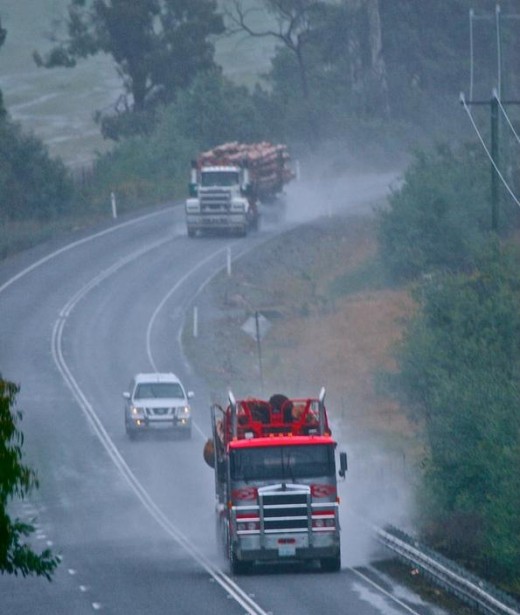 Trucks Logging Tasmania
© Photo by Paul Tapp, Triabunna, Tasmania, 20110718
[Source: http://tasmaniantimes.com/index.php/article/the-triabunna-experiment] Trucks Logging Tasmania
© Photo by Paul Tapp, Triabunna, Tasmania, 20110718
[Source: http://tasmaniantimes.com/index.php/article/the-triabunna-experiment]
.
‘A peace deal between Tasmania’s forestry industry and environmental lobby has been secured by a $274 million government package, raising hopes the long-running conflict is near an end.
.
‘The deal hammered out at the weekend by the Prime Minister, Julia Gillard, and the Tasmanian Premier, Lara Giddings, has the full backing of industry but was criticised by green groups.
The deal ensures existing major logging contracts can be met from forests outside the protected areas but halves the key sawlog quota. The package confirms the reservation of 430,000 hectares of native forest around the state, including the Tarkine rainforests of the island’s north-west and ‘a sprinkling of mountainous coastal forests around the east coast’.
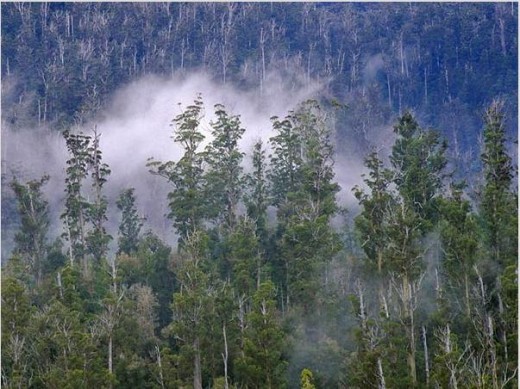
‘With the lion’s share of funds to come from the Commonwealth, the package’s big-ticket items are $85 million to workers and contractors who lose their jobs in industry restructuring, $120 million in extra regional development money for Tasmania and $43 million to implement the changes.
‘The strategically important Triabunna woodchip mill, bought by wealthy environmentalists Jan Cameron and Graeme Wood last week, is to keep operating. But its chips will need Forest Stewardship Council certification, meaning an end for the mass woodchipping of old growth that so divided Tasmania.
‘But one of the chief negotiators, Phill Pullinger of Environment Tasmania, said critical points still lay ahead in translating the weekend’s federal-state heads of agreement into a fully operational process.
‘The federal Greens leader, Bob Brown, said the agreement was a ”Labor-Labor-loggers‘‘ outcome.
”The popular expectation that a 610,000 hectare system of wild forest national parks would be established, as the loggers were bailed out of their failing industry, has been dashed.”
.
[Source: ‘ $274m buys hope that bitter logging dispute is at an end‘, by Andrew Darby, The Age newspaper, Hobart, 20110725]
Read more: ^http://www.theage.com.au/environment/conservation/tasmania-in-274m-forests-deal-20110724-1hves.html
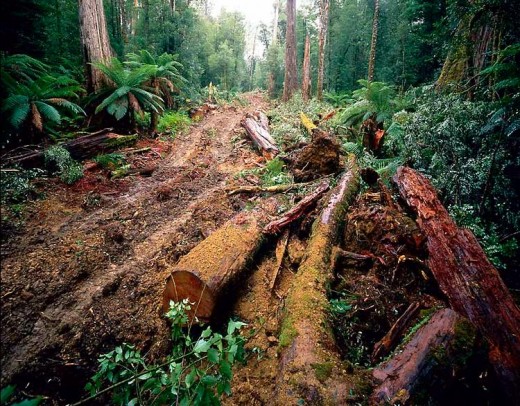 A Forestry Tasmania Footprint
© Photo by Rob Blakers Photography, www.RobBlakers.com A Forestry Tasmania Footprint
© Photo by Rob Blakers Photography, www.RobBlakers.com
http://www.water-sos.org/rob-blakers1.html
‘There has always been good reason to preserve Tasmania’s native old-growth forests. But two years ago the bitter, protracted conflict between loggers and conservationists took a decisive turn.
‘Scientists at the Australian National University revealed that the moist, cool forests of south-eastern Australia are the most carbon-dense environments in the natural world. They store on average more than twice the carbon per hectare than moist, tropical rainforests, which are a more familiar focus of global environmental concerns. Then in May this year, Australia’s new Climate Commission identified the preservation of these forests as critical in limiting Australia’s emissions “while the slower process of transforming energy and transport systems unfolds“.
‘Likewise, the commission estimated billions of tonnes of carbon could be sequestered from the atmosphere if logged areas were reafforested. Add to that the novel intervention of two entrepreneurs who recently paid $10 million for a Gunns sawmill – just so they could close it down – and it seems the three-decade-old impasse over Tasmania’s native forests has finally been broken.
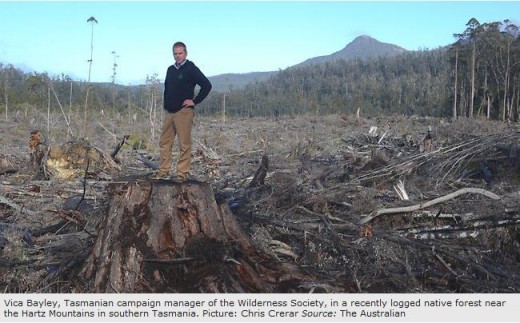
‘This weekend’s $274 million federal government package, which puts 430,000 hectares of native forests off-limits to loggers, is a historic first step. True, the deal between environmentalists and the timber industry is a compromise and not everyone is happy. But the agreement does recognise two crucial claims: the urgent need to protect native forests from further commercial encroachment and the legitimate demand for compensation from communities that have long lived from logging. Tasmania’s small regional economy is vulnerable, which is partly why logging, and the jobs it supports, have long been such a divisive issue. Equally, the dispute has been deadlocked for want of an alternative vision.
‘Globally, forest clearing is responsible for 18 per cent of greenhouse gas emissions. With a carbon tax coming in Australia and numerous carbon trading schemes already operating around the world, such extraordinary carbon sinks as Tasmania’s old-growth forests now have an economic value, not just an ecological one.
‘At the same time, the competitiveness of Tasmania’s woodchip industry has been declining because of the high Australian dollar and low-cost plantations elsewhere. Tasmania’s green credentials have been compromised by images of protesters chained to trunks and of magnificent, ancient trees being felled to satisfy the world’s appetite for woodchips, pulp and disposable chopsticks.
‘Australia’s smallest state should now be able to position itself favourably for the low-carbon economy of the future. That does not rule out supplying high-quality, high-value timber sourced from “certified sustainable” plantations to an environmentally discerning local and global market.’
.
[Source: ‘Old-growth valued at last‘, Sydney Morning Herald, Editorial, 20110725, p.10]
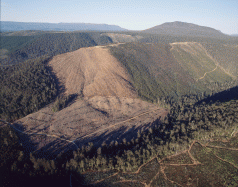 © Photo by Rob Blakers © Photo by Rob Blakers
.
.
Editor’s comment:
.
Government bail out of a 19th Century exploitative industry with taxpayer millions is expedient short term politics ~ throwing other people’s money at the problem. The Labor Gillard Government has just pitched a $274 million bail out package to Forestry Tasmania and its dependents, but as usual the devil is in the detail. That funding is stretched over ten years and is split between the Federal and Tasmanian governments. It seems only $85 million is being made available from Gillard’s bail out in the current year. Her press release (copy below) is unclear on this. Moreover, while $85 million is welcome to Tasmanians, at the same time as Premier Lara Giddings announced recently, Tasmania has been denied a total of around $1.5 billion in expected GST revenue and State taxes from the Federal Government. Tasmanian revenues are being controlled by Canberra. Canberra is treating Tasmania as a welfare state, and a welfare state is what Tasmania is becoming.
.
Twenty-first Century leadership for Tasmania requires triple-bottom line innovative problem solving, listening to all the people of Tasmania.
.
It is incumbent on Tasmanians themselves to strategise a long term competitive and independent vision for Tasmania’s economy and society that respects Tasmania’s natural values. Twenty-first Century political leadership would see the national government encourage this, facilitate a transition process (and not deny GST funding) to trust and enable the island elected Tasmanian Government itself to implement the transition strategies as it sees fit. The transition process demands a quantum investment in vocational education of Tasmanians. So where is that strategy?
.
The crux of Tasmania’s triple bottom line problem in all this is that ‘Tasmania’s small regional economy is vulnerable!’
.
Overhaul and nurture Tasmania’s regional employment to ‘certified sustainability’, since only then may Tasmania’s regional social and ecological systemic problems be resolved with broad community support.
.
In the editor’s view, Tasmania has sufficient natural resources, clean-green industries and innovative entrepreneurs to give New Zealand and its ‘pure’ brand image a run for its money. Tasmania’s natural and human capital just need to be tapped, nurtured and professionally marketed…globally.
.
The following extracts provide some background reading in this issue. Readers can make up their own minds.
.
.
Background Reading:
.
What is the Tasmanian Government’s strategy?
.
Start with the lead agency, termed the ‘Tasmanian Planning Commission’
.
Well it seems its strategy is mainly about urban development. “The current main strategic national priorities are:
- Capital city strategic planning
- Development assessment reform
- Housing affordability
- Climate change (however that is dealt with)
- Retail competition.”
.
What the hell is the Tasmanian Planning Commission’s terms of reference, or is there some other entity delegated to consider Tasmania’s ‘whole of island’ planning?
READ MORE: ^http://www.planning.tas.gov.au/the_planning_system/national_planning
.
.
…meanwhile…’Prime Minister’s press release on the future of ‘Tasmanian Forestry’, 20110724
.
‘Australian and Tasmanian Governments support the future of Tasmanian forestry‘, Sunday 20110724, jointly by the Prime Minister and Premier of Tasmania
[Source: ^http://www.pm.gov.au/press-office/australian-and-tasmanian-governments-support-future-tasmanian-forestry]
.
‘Prime Minister Julia Gillard and Tasmanian Premier Lara Giddings today announced an historic agreement on the future of forestry in Tasmania. In the face of changing market conditions, both in Australia and around the world, it has become clear that the pressure on the Tasmanian forestry industry in its current form is not sustainable. Today’s agreement will secure jobs, ensure a sustainable forestry industry, and achieve iconic environmental outcomes by protecting High Conservation Value forests and remaining old growth forests for future generations.The Heads of Agreement, backed by up to $276 million, will also support workers and their families affected by industry restructure.
Under the Heads of Agreement:
- The Australian and Tasmanian Governments will provide up to $85 million in immediate assistance for workers and contractors who are losing their jobs and livelihoods as a result of industry restructure. This will include employee assistance, retraining and relocation support and assistance for voluntary permanent exits from native forest operations for haulage and harvest contractors (what to?);
- Facilitate sustainable opportunities for the Tasmanian forestry sector with the Tasmanian Government guaranteeing at least 155,000 cubic metres per year in wood supply, 12,500 cubic metres per year of speciality timbers, subject to verification and 265,000 cubic metres of billets, with existing wood supply contracts to be honoured and the Australian Government to fund a voluntary exit mechanism to enable further native wood supply capacity to be retired and reserve areas increased when suitable plantation wood supply is available;
- The Tasmanian Government will reserve and protect 430,000 hectares of native forest from within the 572,000 hectares nominated through the Statement of Principles process, and place the full 572,000 in informal reserve subject to an independent verification process of conservation values and compatibility with yearly guaranteed wood supply, led by Professor Jonathan West. The findings will determine the area of High Conservation Value forest to be reserved, with $7 million a year for their ongoing management to be provided by the Australian Government following incorporation into formal reserves;
- $120 million in Australian Government investment over 15 years, including $20 million in 2011-12, to develop and diversify the Tasmanian economy to drive new job opportunities for Tasmanian families, including through job-creating projects (such as?) in communities affected by forestry restructure. A new ministerial advisory council to be chaired by Mr Bill Kelty AC will drive new regional development opportunities and a new place-based investment Memorandum of Understanding (MoU) between the two governments; and
- The Australian Government will provide $43 million to implement the Heads of Agreement including funding for a range of activities such as working with communities through the transition and provide voluntary compensable exits to sawmillers wishing to exit the native forestry industry.
.
The Heads of Agreement is consistent with the Statement of Principles agreement between environment non-government organisations, the Tasmanian forestry industry and the CFMEU, which was presented by independent facilitator Mr Bill Kelty last month.
It means the forestry industry can continue on a sustainable footing, and guarantees ongoing supply for existing businesses that are critical to supporting jobs and regional communities in Tasmania.The Australian and Tasmanian Governments thank the signatories to the Statement of Principles and Mr Kelty for their commitment and hard work. The Statement of Principles process and the Heads of Agreement reached today creates an opportunity to move forward after decades of conflict and build a stronger future for Tasmania.Governments recognise the significant challenges faced by the industry in the face of global economic and market conditions as well as the historic opportunity provided by forestry and environmental parties coming together to agree on a framework for delivering a sustainable future for the forest industry and the environment. We also recognise that these challenges, as well as the decision by Gunns Limited to exit from native forestry, will have significant impacts on workers, communities and the Tasmanian economy.The Governments clearly expect that following today’s historic agreement environment and industry stakeholders will end the long-running conflict over native forestry. The Governments also expect that the Tasmanian Parliament will pass the required legislation by 30 June 2012. The Australian and Tasmanian governments will work together to identify and support regional economic development through a partnership to create investment and jobs opportunities, particularly for regional communities..
The Australian and Tasmanian Governments will also work together to examine and identify potential opportunities from increased reserves from the Commonwealth Biodiversity Fund. In October last year, the Tasmanian forestry industry and several environmental non-government organisations reached a Statement of Principles for protecting native forests and developing a sustainable timber industry in Tasmania. The Australian and Tasmanian Governments appointed Mr Bill Kelty as an independent facilitator to facilitate talks on the Statement of Principles agreed to between environment non-government organisations, the CFMEU and the forestry industry in Tasmania.’
.
.
…meanwhile…’Independent Strategic Review of Forestry Must Examine Auditor-General’s Report’
by Kim Booth MP, Greens Member for BassKim Booth MP, Greens Forestry spokesperson, Wednesday, 20110706
[Source: ^http://mps.tas.greens.org.au/2011/07/independent-strategic-review-of-forestry-tasmania-must-examine-auditor-general%E2%80%99s-report-and-no-further-public-bail-out-without-parliaments-approval/]
.
‘The Tasmanian Greens today called on the Minister for Forests to ensure that the current independent Strategic Review into Forestry Tasmania includes the Auditor-General’s Special Report 100, Financial and economic performance of Forestry Tasmania, saying that the Report makes it clear that Forestry Tasmania is a failed business and in urgent need of restructure..
Greens Forestry spokesperson, Kim Booth MP, also called for a commitment that no further public monies will be used to bail out Forestry Tasmania from any financial difficulties without such a funding injection first coming before the Parliament.
“I have long been on the record warning the Minister that Forestry Tasmania is a rogue agency that has been unable to return a sustainable commercial rate of return for the Tasmanian public, and is in fact a drain upon the public purse,” Mr Booth said.
“As Shareholder Minister, it is incumbent on him to take responsibility for the fact that the Auditor General formed the view that whilst the ‘expectation of Forestry, and the environment in which it operates, changed fundamentally’ over the last 15 years, the ‘business and funding model did not keep pace with these changes.”
“This Report by the Auditor-General is relevant to the independent Strategic Review of Forestry Tasmania, and the Greens believe it must be formally submitted for the Review’s consideration.”
“With Forestry Tasmania crying poor and the suggestion that more public money might be required to pay their employees superannuation how will the Minister reassure Tasmanians that he will take a more active role in ensuring hard-earned public money is not thrown into the bottomless pit that is Forestry Tasmania?”
“Any further injection of public funds, to bail out this underperforming GBE, should not occur without first seeking Parliament’s approval of any conditions set upon which public money is provided,” Mr Booth said.’
.
.
…meanwhile…’What the community thinks of the forest peace talks’
Media release by Forestry Tasmania, 20110724.
[Source: ^http://www.forestrytas.com.au/news-room/media-releases/what-the-community-thinks-of-the-forest-peace-talks].‘Forestry Tasmania has this morning released a new opinion poll to provide negotiators with an insight into what the community expects out of the forest peace talks.Managing Director Bob Gordon said the survey conducted by respected pollster EMRS for Forestry Tasmania was to his knowledge the only attempt by any of the parties to gain a credible gauge on the community’s expectations and its results therefore could be useful as the Federal and State governments edge closer to a final agreement.
“Finding a durable long lasting agreement that embraced the community’s wishes was always going to be a challenge, and that is reflected in the survey results. The survey found the community wants to strike a balance between environmental outcomes and jobs. When asked to nominate important outcomes, nearly two thirds mentioned protecting old growth forests while 60 per cent nominated jobs. It also found the community overwhelmingly believed that any additional reserves should be determined by rigorous scientific analysis, while less than one in five people thought the State should simply agree to the request by environmentalists to lock up (read ‘save’) 572,000 hectares. It is therefore reasonable to conclude that any agreement must include independent verification of the so called high conservation value forests, if it’s to win community acceptance.”
Mr Gordon said governments also had a communications challenge ahead. “More than half of respondents did not believe they had sufficient information to make an informed decision about the peace talks.”
The EMRS survey of 600 people in late June was part of an ongoing series of tracking surveys that FT has commissioned since August 2008. Mr Gordon said he was delighted that Forestry Tasmania’s reputation had remained strong during a period of considerable turmoil.
“FT’s rating as a good corporate citizen had slipped slightly, but 56 percent had a positive perception of FT compared to 28 per cent with a negative view. “This particular survey indicates there has been a significant shift in community expectations since the previous survey 12 months ago. The community is becoming more concerned about employment and the economy. For example, the percentage of those wanting FT to focus on creating jobs was now at its highest level since March 2009. On the other hand, the percentage of those wanting carbon to be the highest priority had dropped from 30 per cent two years ago to just 13 per cent now.”
.
.
…meanwhile…’Tasmania – $111 million better off with Forestry Tasmania’
Media Release by Forestry Tasmania, 20110722
[Source: ^http://www.forestrytas.com.au/news-room/media-releases/tasmania-111-million-better-off-with-forestry-tasmania]
..
‘Forestry Tasmania has launched a new television advertising campaign highlighting the contribution made by the timber industry to rural Tasmania.The new commercial was shot in Geeveston featuring local workers earlier this week and goes to air for the first time tonight. Forestry Tasmania’s Managing Director Bob Gordon said the commercial draws heavily on the recently released Auditor General’s report into FT’s financial and economic performance, which found Tasmania was $111 million a year better off with Forestry Tasmania operating.
“This report debunks the myth peddled by anti forestry activists that FT and the native forest industry is heavily subsidised and Tasmania would be better off without it. “The fact is the future of many rural and regional communities would be at risk if there was a sudden halt to native forestry. Forestry is the life blood of many, many country towns in Tasmania, and already many are suffering as a result of the forestry downturn.”
Mr Gordon said the $111 million referred to by the Auditor General was conservative.
“Last year, the final value of products produced from state forest timber was $563m – and that’s in a year where forestry was dealing with its worst downturn in memory. That $563m supported in the vicinity of 3,000 full time direct jobs. There are many more workers that indirectly depend on the income from forestry – in retail, hospitality, transport and service sectors. “It’s important to remember that the $111m is just FT’s contribution, it doesn’t include the contribution of the local sawmiller, the local contractor, veneer mills and furniture makers that rely on the wood products harvested from State forests. The full value of the timber industry is around $1.4billion.”
Mr Gordon said FT had committed $14,000 in airtime for the new commercial.
“I’m not going to apologise for spending that money on keeping the community informed and our brand healthy. Too many people depend on FT maintaining a good, strong reputation for us to become squeamish about spending dollars on advertising.”
FT will soon release the results of its latest EMRS poll, measuring corporate brand. The results show FT remains one of the most respected brands in Tasmania, remaining ahead of eight other key businesses and GBE’s.
“Community support for the work we do is still very strong, but this poll is significant because jobs are emerging as the number one issue. People still want a balance between development and the environment, but they think the balance has tipped too far in favour of green ideology, and not enough emphasis is being placed on jobs, particularly in rural and regional communities.”
.
.
…meanwhile…’Step forward for Tasmania’s forests’
Media release by The Wilderness Society (Tasmania), 20110725
[Source: ^http://www.wilderness.org.au/regions/tasmania/step-forward-for-tasmanias-forests]
.
After a campaign lasting more than three decades, the end is now closer than ever in the battle to protect Tasmania’s unique native forests.
With the Prime Minister and Premier Giddings finally coming to the negotiation table, the full implementation of last year’s forest agreement is now in sight. Back in May this year, we suspended our involvement in the Tasmanian forest talks. This was due to inaction by both the Federal and Tasmanian Governments in implementing the forest agreement that was signed by environment groups and the timber industry in October 2010. Now the two governments have finally shown the leadership we have been calling for and the implementation of the historic agreement can now begin.
“This is an important day in the history of the 30-year battle to save Tasmania’s magnificent forests,” said Wilderness Society Tasmania Campaign Manager Vica Bayley.
While the full Statement of Principles has not yet been implemented, this is a major step forward. The next steps in the process will be crucial to bringing a lasting peace in the forests.
Sunday’s signing of the Heads of Agreement between the Federal and Tasmanian Governments maps out a process to immediately protect 430,000 hectares of high-conservation value native forests, with a further 142,000 hectares set aside from logging and awaiting protection subject to verification processes.
The agreement also includes $128 million to assist logging companies and contractors to exit the industry. We will continue to work with other environment groups, unions, the timber industry and both governments to ensure all 572,000 hectares of high-conservation value native forests are protected within world heritage areas and national parks.
The proposed Tamar Valley pulp mill is not part of this latest announcement and the Wilderness Society remains opposed to its construction.
.
.
…meanwhile… back to the subject of Strategies for Tasmania…this is what Tasmania’s leader is focusing on:
.
‘Ministerial Statement: Tasmanian State Services Structural Reforms and Productivity Strategies’
by Lara Giddings Labor Premier of Tasmania
[Source: ^http://www.premier.tas.gov.au/hot_topics/ministerial_statement_-_tasmanian_state_service_structural_reforms_and_productivity_strategies, no date]
.
Introduction
“Mr Speaker, on the 10th of February I released the Mid-Year Financial Report.
The Report detailed the significant financial challenge we face in framing this year’s State Budget. Since then, we have heard in the Federal Budget that Tasmania will lose a further $343 million in GST receipts. That means we have now lost a total of around $1.5 billion in expected GST revenue and State taxes from the Forward Estimates.
Mr Speaker, we are faced with some difficult decisions to ensure we do not go back to the bad old days of the 1990s, when we had spiralling debt, and when we saw funds that should have been spent on services instead being used to pay the interest on that debt. I am determined not to allow the State Budget to slide back into that situation. How we will achieve that will be in next month’s Budget.
But today I want to announce some of the approaches the Government will be taking to help us to return the State’s finances to a sustainable footing while improving the productivity of the public service
In releasing the Mid Year Financial Report, I said the Government would implement a Public Sector Productivity Strategy, with the aim of achieving savings of around $200 million per annum by 2014 15.
Today I will give more detail about some of the ways we will achieve that. Our first priority has been to look at reducing expenses that do not impact on employment, such as phones, cars, travel and the like, but of course those things alone will not be enough to reach our savings target.
In simple terms, the measures I will announce fall into two broad categories. The first set is about making our public service more productive and more efficient The second set is about reducing the cost of our public sector. Both are critical if we are to restore the State Budget to a sustainable footing. The Government’s response to our Budget challenge is not about slashing costs just for the sake of it.
It is about returning the Budget to surplus so we can continue to invest in jobs and services that will ensure Tasmania remains a great place to live. It is about making the right decisions today so we can have a better future.
Mr Speaker, I am aware of the anxiety created in the public service by the Government’s need to find savings.
I know there are many hard working and dedicated public servants who are worried about how these changes might affect them. It is unfortunate that this period of uncertainty has been unavoidable as we work through the issues around the Budget. It is also disappointing that some have chosen to fill the vacuum while we were formulating our response with fear campaigns and misinformation.
In the meantime I have been discussing our approach with key stakeholders, unions, heads of agencies and my Labor and Green colleagues. I hope to be able to allay some of the concerns that have arisen by making it clearer how we will go about making those changes.
That is one reason that I have brought this announcement forward to today rather than leaving it to Budget day next month: so that people will know more about what is happening – and what is not – sooner rather than later.
I value the contribution of our public servants, and indeed strong public services are at the very core of Labor values such as equity, fairness and helping those most in need.
Mr Speaker, I will first outline to the House some of the measures we will be taking to achieve the productivity changes I spoke about – how we will go about achieving greater flexibility and efficiency.
This approach is about making the state service more contemporary, less bureaucratic and more accountable, with a more agile and productive workforce to meet future needs of the Tasmanian community.
Once I have done that I will outline the processes we will follow to reduce our costs. I will not be outlining the exact savings we will be making – that is an issue for next month’s budget.
But I will talk about the process we will follow to ensure employees are treated as fairly, flexibly, compassionately and openly as possible if their positions are identified as no longer being required. The reality is that employee salaries and associated costs make up over 50% of operational expenditure, and in some Agencies this percentage is as high as 70%. Savings in recurrent expenditure of the magnitude that we require can only be achieved through prioritising programs and achieving savings in Agency employment costs.
I have said repeatedly since I released the Mid Year Financial Report that redundancies, and particularly involuntary redundancies, would be a last resort. The measures I announce today are consistent with that approach and will maximise the opportunity for those affected to find new jobs with minimal disruption to their lives.
But where redundancies are required these reforms will ensure affected staff are treated fairly through a clearly understood process. Two of these measures will require legislative change but in large part they are entirely consistent with existing powers and processes
Although they will not be part of the Budget legislation, I will be asking members to agree to the necessary amendments to the Tasmanian State Service Act during the Budget session.
.
Independent State Service Review
Mr Speaker, one of the key steps we will take to address the productivity of our public sector relates to the longer term governance arrangements that should apply to State Service employment.
The State Service Act 2000 underpins all employment in the State Service and establishes governance, employment and structural arrangements for the Tasmanian State Service.
It is time to review these arrangements to guarantee the State Service remains able to meet the challenges of the future.
There are concerns about some aspects of the current arrangements including:
- The clarity of lines of authority
- Support for contemporary workforce management, which allows for flexibility to respond to service delivery, program or policy changes; and
- The number of jurisdictions involved in appeals and reviews (e.g. State Service Commissioner, Tasmanian Industrial Commission, Integrity Commission, Anti-Discrimination Commission).
Mr Speaker, these are concerns that have been raised with me in my discussions with unions, agencies and other key stakeholders and I believe we must address them if we are to make our public sector the best it can be.So today I announce that the Government will commission, through our usual procurement processes, an independent review to examine:
- Employer role responsibilities
- The State Service Commissioner role and responsibilities
- Head of Agency roles and responsibilities
- Tasmanian Industrial Relations Commission roles
- Appropriate grounds of appeal and the correct jurisdiction to determine appeals.
This review will involve consultation and discussion with all stakeholders, including staff, unions and other relevant bodies. In addition the reviewer will be asked to provide recommendations and propose a way forward which may involve amendments to the State Service and Industrial Relations Acts.
State Service Amendment (Performance) Bill 2011
Mr Speaker, improving productivity is essential if we are to maintain a high level of service in the key front line areas – like health, emergency management and education – on which we all depend.Following consultation with agencies and key unions, the Government has determined that performance management, including dealing with underperformance, is a critical component of a Tasmanian State Service “reform agenda” to improve the efficiency and productivity of our public sector.It was also accepted that an authority is required within the legislation to enable us to assist those employees who are struggling or unable to perform the tasks required of them. Most of us want to know if we are not performing to the expectations of our employer, and we need to be given the feedback and the opportunity to improve.It is the Government’s duty as a responsible employer to work with staff to ensure they can perform to the best of their ability, which is good for their morale and career prospects, and obviously a boost for productivity and the quality of service we provide to the public.
We have a responsibility to strengthen our performance management processes, including better training for managers, and indeed that is an issue that unions have raised with me as a way of ensuring staff are given the feedback they need and deserve.
In response, I will be introducing the State Service Amendment (Performance) Bill 2011 to amend the State Service Act 2000 to enable more active management of both performance and underperformance of state service employees.
The amendments will also provide a proper authority for the termination of those employees who after support is given are still unable to perform their duties effectively. It is important that this legislation be introduced at this time to distinguish between this and processes involving surplus employees.
These changes are not a ‘backdoor’ way of sacking people to reduce costs. They are about ensuring our public sector is working efficiently and effectively and providing taxpayers with value for their money. But if at the end of the day some individuals cannot meet those expectations we need a fair and open process to work through.
The provisions of the amendment will ensure that agencies adhere to “due process” (natural justice) in cases involving termination and provide authority to the Minister administering the State Service Act to ultimately, after due process, terminate employment of under-performing employees.
.
Workforce Renewal Incentive Program
Mr Speaker, I have already announced the implementation of a Workforce Renewal Incentive Program.
This program provides an incentive (of up to $20,000) to allow staff to separate from the State Service in certain circumstances, and gives us the opportunity to gain new skills and capabilities in the workforce.
The Program will allow Agencies to renew their workforce and maintain a balanced workforce profile to meet their priority objectives.
The Workforce Renewal Incentive Program is about ensuring the State Service has the right skills profile to meet the challenges of 2011-12 and beyond.
This approach has already been successfully implemented in the Education Department, allowing us to help renew the teaching profession and provide more opportunities for graduates.
.
Vacancy management
Mr Speaker, I now want to turn to the reforms that relate to reducing the cost of our public service.
These changes go to the processes we will follow in seeking to reduce our costs, and how we will attempt to minimise the disruption to the affected individuals in the process.
It is clear that we will not be able to maintain public service employee numbers at the current levels – it’s just not sustainable. Recognising this situation, the Government will put in place a range of measures designed to support Agencies in managing reductions in employee numbers.
As I have consistently said, redundancies will be the last resort. And if we do have to offer redundancies, they will be targeted and limited to positions that are no longer required. We will not be offering mass redundancies because they are too costly and they are not strategic.
Invariably when you open redundancies to anyone who wants to go you lose skills and experience that you did not want to lose. So, if we identify that a position is no longer required the first step we will take will be to see if the person in that position can be redeployed to a vacancy within their own agency.
Each agency has already implemented internal vacancy management measures. These will ensure that each position that becomes vacant will be fully reviewed before any recruitment process is started to determine:
• If it is essential for the position to be filled;
• If the classification level of the position is appropriate; and
• If there are any surplus employees within the agency able to fill the position.
Internal agency vacancy management also encompasses other strategies such as:
• the timing of filling the vacancy;
• the ability of the position to be filled on part-time or job-sharing basis;
• natural attrition following normal separation (abolition of funded vacancies);
• restructuring within Agencies where programs or services are to be discontinued;
• reviewing the need for specific fixed term employment;
• reassignment of duties to existing employees (within the Agency);
• increased approval of leave without pay applications;
• increased approval of secondments to organisations outside the State Service (where available);
• increased use of flexible working arrangements, such as part time employment; and/ or
• workforce re-profiling and utilisation of the Workforce Renewal Incentive Program that I mentioned earlier.
.
Inter-agency vacancies
Mr Speaker, if a member of staff who is surplus to requirements cannot be redeployed within their own agency the next step will be to see if their skills can be used in another agency.
I will be issuing a Ministerial Direction that details procedures to manage inter-agency vacancies. The Direction will ensure that there is a whole of government approach to matching surplus employees with vacancies that exist across all agencies.
It is essential that there is a consistent and coordinated approach to these strategies and the Public Sector Management Office (PSMO), within the Department of Premier and Cabinet is to be the single contact point for matching surplus employees and vacancies.
Where a Head of Agency is unable to identify suitable vacancies within the agency, he or she may recommend to the independent State Service Commissioner, who will oversee the process, that an employee be made available for redeployment in accordance with section 47 of the State Service Act 2000.
In the case of a Senior Executive Service (SES) officer, the Secretary of DPAC is advised.
Employees and officers accepted as surplus may be considered on a suitability basis for transfer to vacant state service positions in other agencies. Assessments of suitability will be undertaken by assessment panels established by agencies for that purpose. The purpose of a suitability assessment is to determine whether the referred employee/officer can satisfactorily carry out the duties either immediately or within a reasonable time given appropriate training and experience.
.
External placement of surplus employees
Mr Speaker, the next step if staff who are no longer required cannot be redeployed within government will be to see if we can assist them to find work externally.
The Public Sector Management Office will explore career or specific job opportunities external to the Tasmanian State Service for surplus employees and officers, including permanent and fixed term placements. The terms and conditions of any external placement will be negotiated with the relevant parties in accordance with Section 46 of the State Service Act.
PSMO will also establish a schedule of preferred providers that may be available to assist surplus employees. These will include, but not be limited to:
• Career Planning;
• Outplacement;
• Job search;
• Counselling (Employee Assistance Program);
• Financial management;
• Superannuation; and
• Taxation
Agencies may refer surplus employees at any time to the above support services and will, in consultation with their employees, decide the appropriate provider, type and level of advice to assist the employee.
Targeted voluntary redundancy arrangements
Mr Speaker, the Government is currently reviewing its targeted voluntary redundancy arrangements, and I would hope that these, combined with our vacancy control and redeployment measures, will help to minimise the need for any involuntary redundancies.
As I have already said, the emphasis of these arrangements will be on specific targeted redundancies within identified programs, rather than a general offer of voluntary redundancies across a range of program areas, as has been the previous approach.
This will better align our voluntary redundancy arrangements with the structural reform and productivity strategies required to meet our Budget task.
The renewed arrangements will also be designed to:
• place greater onus on Heads of Agency to consider and exhaust other options before offering voluntary redundancies;
• ensure greater emphasis on justifying the cost/benefit of voluntary redundancies before offers are made;
• improve flexibility by incentivising redundancies where other alternatives have been exhausted and early voluntary separation is both desirable and cost effective; and
• minimise the need for involuntary separations.
Changes to Section 47
Mr Speaker, currently the Tasmanian State Service Act provides for a twelve month redeployment period for employees declared as surplus under Section 47.
After much discussion within Government and Cabinet this period was considered to be too long. The Government did consider moving to a three month period but it was agreed that this was too short to allow all options for employees to be redeployed to be explored.
As a result, the Government intends to introduce an amendment to section 47 of the State Service Act which will limit the maximum redeployment period to six-months.
Some other jurisdictions do not specify any redeployment period for surplus employees, though they do require genuine attempts to be made to redeploy surplus employees before termination occurs.
Industrial precedent and decisions in Industrial Tribunals require that an employer demonstrate that redeployment attempts have not been successful, or are not available.
A six-month period is reasonable for inter-agency and alternative strategies to be properly explored. In some cases, particularly for an employee with highly-specialised skills and employment needs, the likelihood or otherwise of redeployment would be established well within this timeframe.
A six-month period appropriately balances redeployment requirements and the costs of continued employment. A longer period of uncertainty also has a negative impact on the employee and the workforce generally.
.
Involuntary redundancies
Mr Speaker, once all of the options I have detailed have been exhausted the very last step we may be forced to take is involuntary redundancies.
I can inform the House that the Government will not be seeking to amend Section 44 of the State Service Act to allow for involuntary termination on economic and operational grounds.
I recognise that some stakeholders were concerned that we might have chosen this path because they feared it could lead to widespread and abrupt redundancies without the type of redeployment options and voluntary processes I have spoken about today. This was an issue of particular concern to unions and my Labor and Greens colleagues.
Instead, if required we would seek to achieve the savings required through the existing provisions of Section 47 of the current State Service Act, which was introduced in 2000 by the Bacon Labor Government.
Section 47 provides for termination after it is has been declared that suitable redeployment has not been available through the various processes I have detailed. Previously, it has been unclear under Section 47 whether an involuntary redundancy package should be made available after this declaration is made.
To ensure there is no longer any doubt, the Government has agreed that, should this stage be reached, after the opportunity has been given to take a voluntary redundancy or pursue redeployment options over six-months, the affected employee will be entitled to a redundancy package.
This package should reflect a balanced and reasonable approach based on the need for “fair” treatment of our employees while recognising the financial benefit that accrues through having had a guaranteed six month paid redeployment period.
The package will contain a minimum payment consistent with the Targeted Voluntary Redundancy Arrangements. The package will also contain a ‘years of service’ payment.
The difference between the package for a ‘voluntary offer and acceptance’ and an involuntary redundancy will need to take into account the benefits that accrue to an employee who remains on redeployment for the full 26-weeks.
We will finalise the details of the involuntary redundancy entitlements following further discussion and consultation with the Unions.
Conclusion
In conclusion, Mr Speaker, the current fiscal situation means the Government is no longer able to meet its budget targets, and we risk moving into an unsustainable position if action is not taken.
Improving the efficiency and productivity of the state service, and reducing our costs, are key strategies we will be implementing in the coming months. But this is also about strengthening our public sector so it can better perform its key role – providing services to the Tasmanian community.
It is important to remember that the majority of employees will not be affected by decisions that identify programs that are no longer required. But I am very conscious that the changes we need to make should be done fairly and openly so we can minimise concerns among staff and the impact on the affected individuals.
That is why I have detailed today the measures we will be implementing and the processes we will be following, and I will ensure that all of our public servants are made aware of what we will be doing.
And I hope that by releasing more details about the direction we will be taking we can allay some of the concerns and fears that have arisen in recent weeks, and we will continue to work with staff and unions as we work through this process.
I believe these changes will lead to a more productive and efficient public service. They will reduce the Government’s costs at a time of financial pressure, and they will do so in a way that gives affected staff the best chance of finding alternative employment. And for employees who find themselves in areas where the positions they occupy are no longer required, it is critical that the alternatives available to them should be fair and clear.
I believe the range of measures I have announced today will help us to achieve all of these goals as we negotiate the difficult times ahead.”
.
.
– end of article –
Tags: certified sustainable, Environment Tasmania, forest peace talks, Forest Stewardship Council certification, Forestry Tasmania, Gunns, Julia Gillard, Lara Giddings, logging trucks, old growth, Phill Pullinger, sawlog quota, Strategies for Tasmania, Tasmania welfare state, Tasmania's old-growth forests, Tasmanian logging, Tasmanian Planning Commission, The Wilderness Society, Triabunna, wildtasmania.org, Woodchipping Tasmania
Posted in Tasmania (AU), Threats from Deforestation, Threats to Wild Tasmania | No Comments »
Add this post to Del.icio.us - Digg
|
|
 ‘As you visit this special country, please take care to Leave No Trace!’
‘As you visit this special country, please take care to Leave No Trace!’
 “I am the way and the truth and the life.
No one comes to log except through me.”
“I am the way and the truth and the life.
No one comes to log except through me.”
 Logging Canada
Logging Canada
 Logging British Columbia
Logging British Columbia
 Logging Oregon ~ that’s a ‘single rider’
Logging Oregon ~ that’s a ‘single rider’ Logging Tasmania like there’s no tomorrow..and they were right
Logging Tasmania like there’s no tomorrow..and they were right
 Logging Borneo
~ a rearward perspective
Logging Borneo
~ a rearward perspective Logging more of Borneo
Logging more of Borneo
 Logging Gabon, west African rainforest
Logging Gabon, west African rainforest
 Get out of my bloody way!
It’s logging season and they could change the laws next week!
Get out of my bloody way!
It’s logging season and they could change the laws next week! Quality Control in Tasmanian Logging
Quality Control in Tasmanian Logging
 Triabunna’s Forest Death Camp
Triabunna’s Forest Death Camp
 Burnie’s Forest Death Camp
Burnie’s Forest Death Camp
 Woodchip Town
~ home of loggers…twenty eight generations at least!
Woodchip Town
~ home of loggers…twenty eight generations at least!
 Politicians froth at the prospect of launching anything in front of the media
..here Tasmanian then Premier David Bartlett launching ‘the veneer’ of the Veneer Mill in Smithton in 2008 – ‘plantations only’
.
Politicians froth at the prospect of launching anything in front of the media
..here Tasmanian then Premier David Bartlett launching ‘the veneer’ of the Veneer Mill in Smithton in 2008 – ‘plantations only’
.
 Logging Mogul, Abdul Hamed Sepawi
Malaysian millionnaire boss man and logger pay master – owner of multinational logger ‘Ta Ann’
Logging Mogul, Abdul Hamed Sepawi
Malaysian millionnaire boss man and logger pay master – owner of multinational logger ‘Ta Ann’
 Stihl logged – Tasmanian Native Forests
“Tasmanian eucalypt veneer is particularly well regarded on international markets” ~ Sapawi.
Stihl logged – Tasmanian Native Forests
“Tasmanian eucalypt veneer is particularly well regarded on international markets” ~ Sapawi.
 Tasmania’s Weedy Sea Dragon
… appropriated for Chinese gain over Tasmania and Tasmanians ~ wake up!
Tasmania’s Weedy Sea Dragon
… appropriated for Chinese gain over Tasmania and Tasmanians ~ wake up! Here’s a logo to send back to the Chinese loggers!
Here’s a logo to send back to the Chinese loggers!
 Like all great loggers, I have seen more than I remember, and remember more than I have seen.
Like all great loggers, I have seen more than I remember, and remember more than I have seen. Last Tree Standing
Last Tree Standing
















